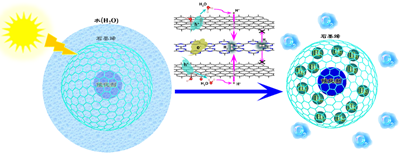The use of Hydrogen energy was proposed in the last century as a ‘perfect’ solution to the short of energy. In hydrogen economy, people would utilize the solar energy to split water into hydrogen and oxygen. Hydrogen burns to produce energy, and turns into water, doing completely no harm to the environment. Yet for a long time, the research on photocatalytic water splitting has remained stagnant, as the great difficulties in separating and safely storing hydrogen repelled researchers from making further progress.
Recently, a team led by Prof. JIANG Jun and Prof. ZHAO Jin from the National Laboratory of Physical Science at Microscale has proposed a multi-layer structure where the produced hydrogen is completely isolated and stored with a high-density level, significantly promoting the possibility of converting solar energy to hydrogen energy.
The new structure is like a sandwich, where a carbon nitride(C3N4) layer lies between two graphene sheets modified by different functional groups. As a metal-free system, GR–C3N4 composite layers can effectively harvest visible solar light. GO–CxNy (GO: GR modified by hydroxyl and epoxy groups) generates excitons, which soon separate to energetic electrons and holes. Then the electrons and holes are separately delivered to reductive and oxidative reaction sites. Water molecules are absorbed to the surface of graphene, waiting to be split. Noticeably, the functional groups on the graphene sheets could collect much hole carriers after adsorbing water molecule, making it ready for oxidative reaction. Moreover, these groups effectively reduce the energy barrier for water splitting. After that, protons produced at the oxidative sites would penetrate through the outer layers to meet the inner ones, thus hydrogen is generated. As hydrogen cannot pass through GR-based material, it would be capsuled inside the sandwich.

(Image by JIANG Jun)
The ability of integrating photocatalytic hydrogen generation and safe capsule storage has made the structure an exciting candidate for realistic solar and hydrogen energy utilization. Furthermore, other SP2 hybrid carbon materials modified by functional groups and other photo-catalysis could also fit this structure. This multi-layer design solves the problem of separating and storing hydrogen and may have re-found the path to hydrogen economy.
The paper entitled ‘Combining photocatalytic hydrogen generation and capsule storage in graphene based sandwich structures’ was published on Nature Communication. This work was funded by Youth 973 Project of Ministry of Science and Technology, The National Natural Science Fund, Leading Programs of Chinese Academy of Science, and the Ministry of Education.
The link of the paper: https://www.nature.com/articles/ncomms16049
Contact: Prof. JIANG Jun
E-mail: jiangj1@ustc.edu.cn
http://www.hfnl.ustc.edu.cn/2013/0822/4241.html